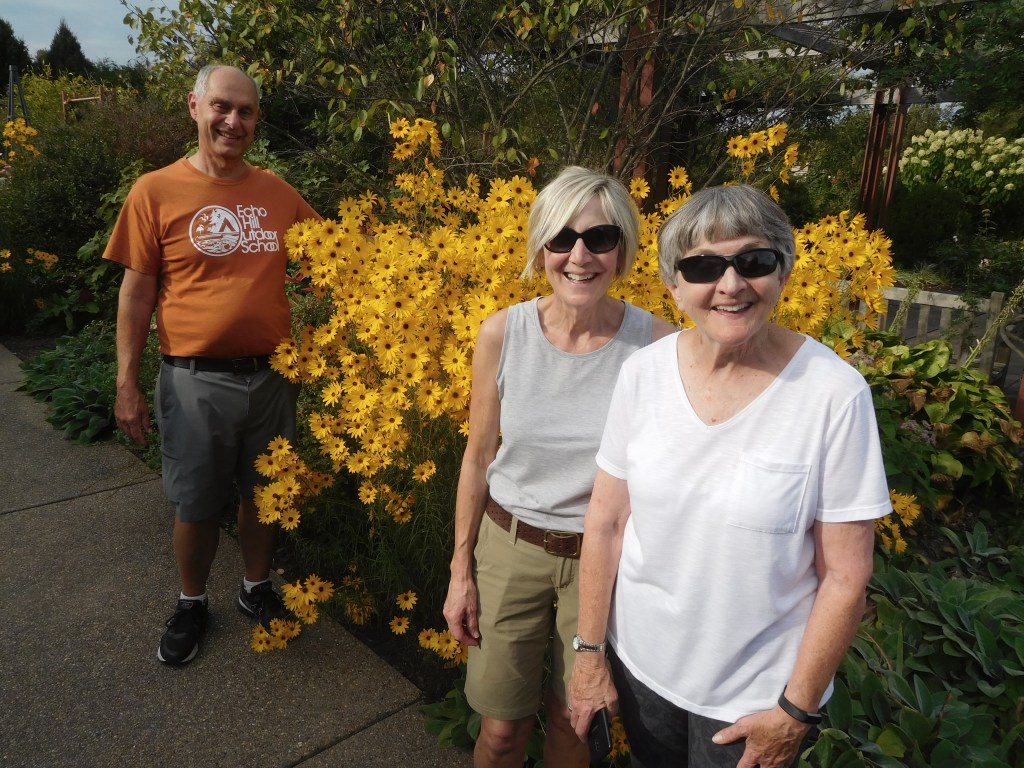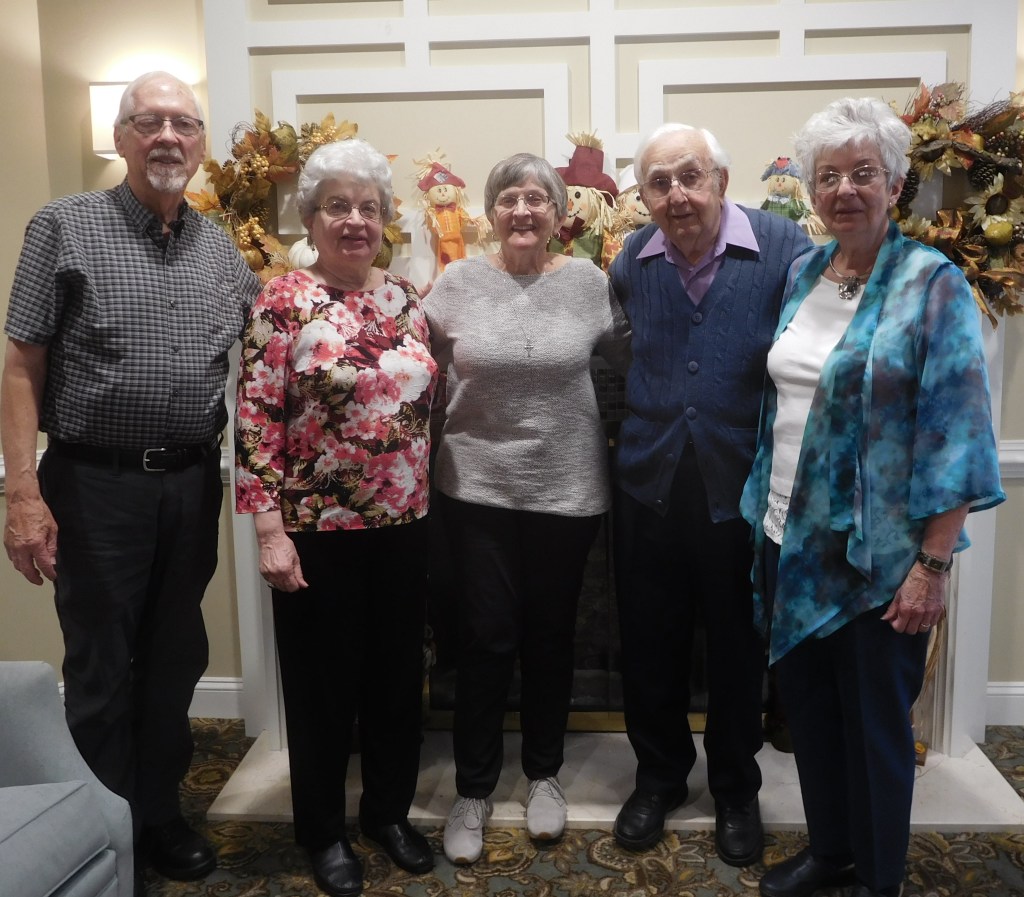Cogitation 45/222 Saturday 9 November 2019 The vastness of forests, mountains, hills, rocks, sky, rivers, lakes and ocean, and migration of butterflies and geese impressed me on our recent 5-week trip east, north, west and south (OH. PA, MA, ME, NB, NS, QC, ON, MI, IN).

The trip centered on interaction with friends and family to and from a visit to the Art Gallery of Nova Scotia in Halifax. People interactions included catching up over meals, walks, birthday parties, and seeing the sights.
I’d say we saw more wilderness than cultivated land on our journey by car. We experienced the vagaries of weather, from Nor’easters, heavy rains, many tranquil splashes of sun, and a day of snow near the end.
Now at home, how do I summarize? Hardly by a recount of the political news we saw in the papers and on the telly. Hardly by condensing the too lengthy opinion pieces in the papers. Hardly by a treatise on the quality of the mattresses we slept on. Hardly by giving a step-by-step account of our drive, including the give and take between GPS and M.A.P. (I like the big picture a paper map gives and find GPS confusing at times).
Not even detailing the fine museums we visited (next week I’ll write about the Art Gallery of Nova Scotia and the Maud Lewis collection). Not even by reviewing the books we bought or the variety of road signs we encountered.
So, what then? I’ll try to summarize how these various elements created a pleasing whole. A balance. A goodly sum.
Naturalist John Muir used the term, “beauty and bread” to describe what humans need. He wrote: “Everyone need beauty as well as bread, places to play in . . . where nature may heal and cheer and give strength to body and soul.”
I’ll transpose Muir’s order to “bread and beauty” and use food as the takeoff point for the “cups overflowing” summary of our experiences on the road.
I’ll start off with a cup of tea, Red Rose Orange Pekoe. The envelope says, “Your small cup can make a big difference. Votre petite tasse pourrait avoir une grande importance.” The package adds, “This product is packed in a zero landfill facility.” The Tea Council of Canada gives it four stars. And it’s Rainforest Alliance Certified. Wow, that’s a lot of freight in a small package.
Nothing like a cuppa to set the stage.
The goodness we shared



New England clam chowder topped the meals along the North Eastern shore. We ate lots of seafood, but held off on “Market Price” lobster, except for a lobster roll and a mug of lobster bisque.
In Boston, we did have lunch, with other tourists, at the bustling Cheers, the exterior model for the old TV show by the same name. I must say the bean bowl was not my favorite meal of the trip, but I’m glad to have indulged. Same for the meal of poutine at Snack Bar D’Amours in Riviere du Loup, QC. They closed in early November, with this notice on the receipt: “Merci de votre commance. Bonne Saison 2019.”




The Curated Guide, featuring a selection of culinary destinations in and beyond Halifax, reveals we did find some of the recommended spots on our own. I did not have time to match the multiplicity of restaurants to the map while in Halifax. I’d be better prepared for another time.
Pizza at Salvator’s Pizzaiolo Trattoria in the historic Hydrostone district, was worthy of its “Best of” award. That was close to our small guest apartment. Twice we walked into the downtown and south end from our lodging in the north end.

The bag of McIntosh apples from Stirling Fruit Farms in Wolfville, NS, (with other locations in the province and in New Brunswick) proved tasty, as did a bag of Cortlands, along with cheese, from the Abbaye de Saint-Benoit-du-Lac in the Eastern Townships, Quebec.

The meal at an Indian Restaurant in Brockville with cousin Dale was satisfyingly spicy and tasty, as was the chicken dinner Dale prepared at home.


The meals at Wasaga Beach, Ontario, where my siblings and their spouses gathered for five days, too, are memorable, including those cooking all day in the crockpot, to food from the oven, stove top and grill. For his birthday meal Sandy chose a Chinese restaurant in nearby Collingwood. Scrumptious all.


Post Wasaga Beach: Vivian, with whom we stayed for two nights before heading home, made a wonderful meal for her immediate family to celebrate daughter Amy’s birthday.

A ‘rich soup’

I barely got going in reading The Lost Art of Reading Nature’s Signs by Tristan Gooley. Gooley is a master at using outdoor clues to find your way, predict the weather, locate water, track animals, and practice other forgotten skills.
I thought of Gooley’s observational skills as we coursed along highway and byway. One quote: “It is a balancing of strengths and weaknesses that will dictate the trees that come to color an area and in turn allow us to read the woods like a map. For example, if we are descending into a river valley and suddenly pass through a lot of sycamores and ashes, we can be fairly confident we have reached the floodplain. Sycamore and ash trees need very fertile soils, but tolerate wet conditions and so can make these valley floors their own, thriving where the water and nutrients get washed together in a rich soup.”

Gooley gives me a metaphor for summarizing our trip. We’re thriving on all the nutrients gained by interaction with dear friends and family, with nature, with countryside, towns and cities, with art and history, with regional foods, with extended time in the car, all “washed together in a rich soup.”
Now, what to do with the 5.7 kg (12.5 lbs) of pamphlets and papers that have been saved from the recycling pile? Plan another trip? Not right away, other than in armchair travel for a while.
Like John Muir, I think George Herbert (1593-1633) had a kindly view of humankind’s place within and for creation, not the pillaging that has been present since the Industrial Revolution. “For us the winds do blow, / The earth resteth, heav’n moveth, fountains flow; / Nothing we see but means our good, / As our delight or as our treasure; / The whole is either our cupboard of food / Or cabinet of pleasure.”
We can benefit humanity and nature immensely by taking up John Muir’s balanced view of our need to enjoy and care for the natural world: Again, “Everyone needs beauty as well as bread, places to play in. . . .”
Natures healing and cheer, to paraphrase Muir, gave strength to my body and soul many times over. Especially was that true as we walked the Jordan Pond Path loop in Acadia National Park in Maine (3.2 mile, 5.1 km).

I had spent the morning in Bar Harbor getting tests and prescriptions for a medical condition. The care of the medical staff and the afternoon walk unfolded as a spiritual experience, food for body and soul, beauty and bread overflowing, including being blessed with the grace of satellite navigation to correct our befuddlement in getting back to our motel as darkness fell, where we happily consumed takeout burgers from a nearby general store, along with chips and chocolate
Overflow




May your travel cup, even, and especially, in your armchair, be full to overflowing.
-John


Thanks, John, for sharing your trip in this way. There’s another installment (or two), right? I enjoyed your trip vicariously.
LikeLike
Hi Steve, you may have just inspired further “road work.” We’ll see how the next couple blogs develop. Thanks for your encouragement.
LikeLike
I loved traveling with you and Marty
Muir and Herbert came along as well
Beautiful
Ellie Kreider
LikeLike
Thanks, Ellie. You are the inveterate traveler with friends in many places. As well as in books. See you soon!
LikeLike
Thanks for the shared memories. The memories of the cottage in Wasaga Beach warm the heart all over again and your road trip stirs the itch to travel to new paths.
Sent from my iPad
>
LikeLike
Yes, Vivian, Wasaga Beach wears well with us, too. We can do something such all over again. Will talk about it at Christmas. And practice it in Cornwall. Best!
LikeLike
A delightful expose of your travels John. Blessings.
LikeLike
Let rise the day when our paths may cross again. In the meantime, it’s a delight to have you follow the blog. Best!
LikeLike
The map, pegged with your stops, is a good summary on its own. Ahhh. Red Rose Tea! I look forward to learning to know Maudie at movie time this week.
LikeLike
Thanks, Alice, I raise a cuppa to you and Willard. See you soon.
LikeLike
Sounds like a good trip, John. You covered lots of ground and saw many friends and family! I imagine you are happy to be home now and have time to plan for Cornwall. We leave for Florida on Dec 3 so we are starting to pack and prepare for being gone for 5 months.
Monty & Ginger
LikeLike
Thanks, Monty. Sunshine, whether in the cold or in the warm, makes me smile. Best as you plan for your winter sojourn in the sun.
LikeLike